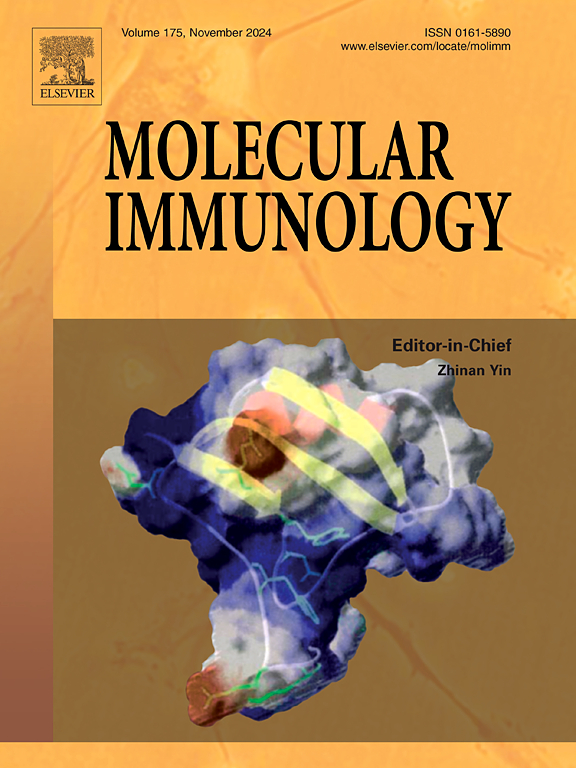Darutoside promotes skin wound healing via regulating macrophage polarization
IF 3.2
3区 医学
Q2 BIOCHEMISTRY & MOLECULAR BIOLOGY
引用次数: 0
Abstract
Wound healing is a complex and dynamic process of tissue formation, while polarization of macrophages plays an important role during this process. Darutoside is one of the major components of the ethanol extract from Siegesbeckia, which has the effects of anti-inflammation, healing rheumatism and promoting joint health. To investigate whether darutoside could promote wound healing, we established full-thickness excisional cutaneous wound healing model in C57/BL6 mice and applied darutoside on the skin wounds. The results showed that darutoside can improve wound healing in mice. Mechanistically, we treated RAW264.7 and macrophages with darutoside in vitro, and found that darutoside inhibited the LPS-induced polarization and pro-inflammatory cytokines expression in macrophages by inhibiting NF-κB signaling pathway. For in vivo study, we also found that darutoside could promote the growth of epithelial cells in wound tissue and inhibit the expression of iNOS+ macrophages around wound tissue by IHC staining. In addition, we also found that darutoside could inhibit the expression of inflammatory factors in wound tissue by PCR. Our data revealed that darutoside could promote wound healing by regulating macrophage polarization via inhibition of NF-κB signaling pathway.
达鲁托苷通过调节巨噬细胞极化促进皮肤伤口愈合
创面愈合是一个复杂而动态的组织形成过程,巨噬细胞的极化在这一过程中起着重要作用。达鲁托苷是茜草醇提物的主要成分之一,具有抗炎、治疗风湿、促进关节健康的作用。为了研究达鲁多苷是否能促进创面愈合,我们建立C57/BL6小鼠全层切除皮肤创面愈合模型,并在创面上涂抹达鲁多苷。结果表明,达鲁多苷能促进小鼠创面愈合。机制上,我们在体外用达鲁托苷处理RAW264.7和巨噬细胞,发现达鲁托苷通过抑制NF-κB信号通路抑制lps诱导的巨噬细胞极化和促炎细胞因子的表达。在体内研究中,我们也通过免疫组化染色发现达鲁托苷能促进创面组织上皮细胞的生长,抑制创面组织周围iNOS+ 巨噬细胞的表达。此外,我们还通过PCR发现达鲁托苷可以抑制创面组织中炎症因子的表达。结果表明,达鲁托苷通过抑制NF-κB信号通路调节巨噬细胞极化,从而促进创面愈合。
本文章由计算机程序翻译,如有差异,请以英文原文为准。
求助全文
约1分钟内获得全文
求助全文
来源期刊

Molecular immunology
医学-免疫学
CiteScore
6.90
自引率
2.80%
发文量
324
审稿时长
50 days
期刊介绍:
Molecular Immunology publishes original articles, reviews and commentaries on all areas of immunology, with a particular focus on description of cellular, biochemical or genetic mechanisms underlying immunological phenomena. Studies on all model organisms, from invertebrates to humans, are suitable. Examples include, but are not restricted to:
Infection, autoimmunity, transplantation, immunodeficiencies, inflammation and tumor immunology
Mechanisms of induction, regulation and termination of innate and adaptive immunity
Intercellular communication, cooperation and regulation
Intracellular mechanisms of immunity (endocytosis, protein trafficking, pathogen recognition, antigen presentation, etc)
Mechanisms of action of the cells and molecules of the immune system
Structural analysis
Development of the immune system
Comparative immunology and evolution of the immune system
"Omics" studies and bioinformatics
Vaccines, biotechnology and therapeutic manipulation of the immune system (therapeutic antibodies, cytokines, cellular therapies, etc)
Technical developments.
 求助内容:
求助内容: 应助结果提醒方式:
应助结果提醒方式:


